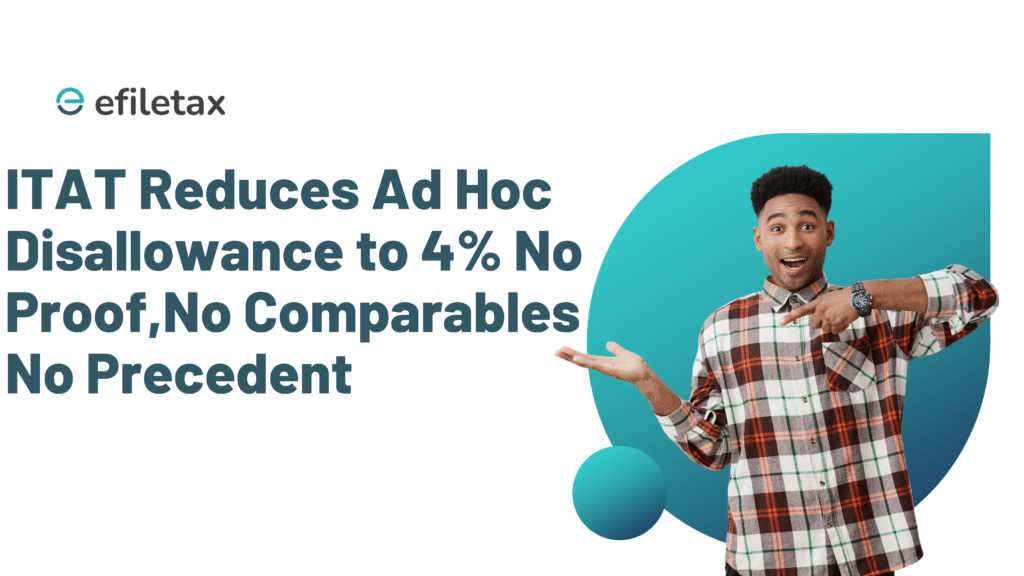
ITAT Reduces Ad Hoc Disallowance to 4%: No Proof or Comparables Cited
In a recent tax ruling, the Income Tax Appellate Tribunal (ITAT) significantly reduced an ad hoc disallowance from 10% to 4%. The key reason? The Income Tax Department failed to provide comparables, and the assessee couldn’t furnish proper proof. This decision, however, was clearly stated not to be treated as a precedent.
Let’s break down what this means for you — especially if you’re a business or tax consultant dealing with scrutiny assessments.
Background of the Case
The case involved a taxpayer engaged in wholesale trade of automobile spare parts.
- The Assessing Officer (AO) disallowed 10% of purchases on an ad hoc basis.
- The basis: Suspected inflated purchases and lack of clarity in vendor documentation.
- The taxpayer failed to provide full supporting documents like delivery challans or confirmation letters.
- However, the Income Tax Department also failed to provide any comparable data or concrete evidence to justify the 10% disallowance.
ITAT’s Key Observations
The ITAT bench noted:
- No evidence from the Department to back the 10% figure.
- No industry comparables or third-party confirmations were placed on record.
- The assessee did maintain books of accounts and filed audit reports under Section 44AB.
- In absence of proof from both sides, a reasonable estimate had to be made.
👉 Result: The disallowance was reduced from 10% to 4% of the purchases.
🔒 Important: The order explicitly states it is not to be treated as a precedent for future cases.
What is Ad Hoc Disallowance in Income Tax?
Ad hoc disallowance is a subjective estimation made by tax officers when:
- There are gaps in documentation.
- Expenses appear excessive or unverifiable.
- No direct evidence of evasion is available.
However, courts have held in multiple rulings that:
- Ad hoc additions must be reasonable.
- There should be some basis or comparable data.
- Arbitrary disallowances are not sustainable.
📜 Legal References:
- CIT v. M/s Inamdar & Sons [Bombay HC]: Disallowance without rationale cannot stand.
- PCIT v. NVS Builders Pvt Ltd [Delhi HC]: Mere suspicion isn’t enough for high disallowance.
Expert View: Maintain Proper Vendor Records
Chartered Accountants advise that:
✅ Keep signed invoices, delivery notes, and payment proofs.
✅ Use vendor confirmation letters in audit files.
✅ Ensure reconciliation of GSTR-2B with books in GST regime.
✅ Avoid cash purchases beyond ₹10,000 per day per vendor (Section 40A(3)).
📌 Pro Tip: Even if you deal in bulk or semi-formal markets, email or WhatsApp confirmations from suppliers can help avoid disallowances.
Key Takeaways for Taxpayers
Here’s what you should keep in mind:
| Issue | ITAT Finding |
|---|---|
| Lack of documentation | Not a full reason to disallow 10% |
| No comparables from Dept | Weakens I-T Dept’s case |
| Ad hoc % disallowance | Reduced to 4% |
| Precedent Value | Not applicable for other cases |
Conclusion
This ITAT ruling shows that both assessee and tax officers need to back their claims with solid proof. While a 4% disallowance may seem minor, it highlights the importance of maintaining clean books and documentation — especially under scrutiny.
If you’re facing scrutiny, Efiletax can help you with:
- Documentation audits
- GST and purchase matching
- Representation before tax authorities
🔗 Get Expert Support with Efiletax →
FAQs
Q1. Is ad hoc disallowance legal?
Yes, but it must be based on reasonable estimation — not arbitrary figures.
Q2. Can ITAT decisions be used in other cases?
Only if the ruling doesn’t state it’s “not a precedent.” In this case, it can’t be relied on.
Q3. What if I lose vendor bills?
Try to get bank statements, e-way bills, or supplier confirmations to defend your claim.
Summary:
ITAT reduced ad hoc disallowance from 10% to 4% as neither the assessee nor the Income Tax Department provided solid proof. This order is not a legal precedent but serves as a reminder to maintain proper records.